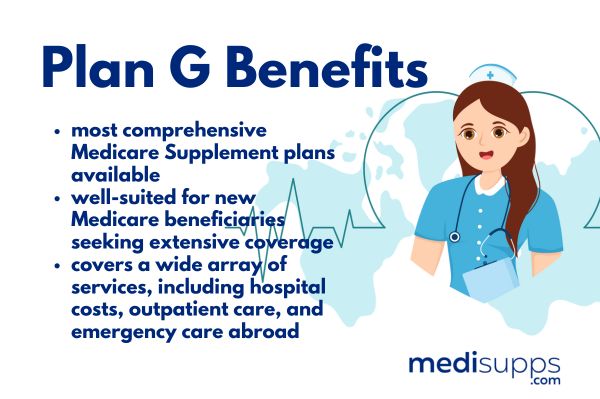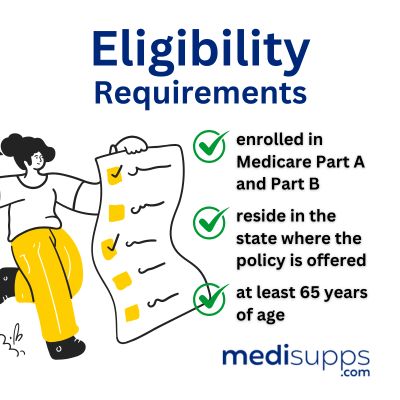
by Russell Noga | Updated March 14th, 2025
Trying to navigate Medicare supplement plans Colorado? This article will walk you through everything you need to know – from understanding different Medigap policies to comparing costs and enrollment periods. Get ready to make an informed choice about your healthcare coverage.
Key Takeaways
- Medicare Supplement Plans, or Medigap, help cover out-of-pocket costs not paid by Original Medicare, such as deductibles and copayments.
- In Colorado, popular Medigap options include Plans F and G, which offer comprehensive coverage, while cost variations exist due to different pricing models by insurance providers.
- The best time to enroll in a Medigap plan is during the Open Enrollment Period that begins when you turn 65 and enroll in Medicare Part B, ensuring guaranteed issue rights.
Compare 2026 Plans & Rates
Enter Zip Code
Understanding Medicare Supplement Plans in Colorado

Medicare Supplement Plans, commonly known as Medigap, are private insurance policies designed to fill the gaps left by Original Medicare. While Original Medicare covers a significant portion of healthcare costs, it doesn’t pay for everything. That’s where a Medicare supplement plan comes in, covering costs such as deductibles, copayments, and coinsurance that Medicare beneficiaries would otherwise have to pay out-of-pocket. These plans are standardized by Medicare and regulated by state laws and insurance commissioners to ensure consistency in benefits across different providers. Medicare supplement insurance plans provide additional coverage options for those seeking more comprehensive protection.
In Colorado, like in other states, Medigap policies are not connected with the U.S. Government but are offered by private insurance companies. This means that while the benefits of plans with the same letter are standardized, the prices can vary significantly between different companies. Therefore, consumers should contact insurance companies directly to get quotes and detailed policy information before making a decision.
The primary difference in Medigap policies with the same letter from different companies is their price. This variance is due to factors such as the company’s pricing model and administrative costs. Hence, shopping around and comparing quotes helps you find the most cost-effective plan that meets your needs.
With a clear understanding of what Medigap plans are and how they function, you’re well on your way to making an informed choice.
Coverage Details of Colorado Medigap Plans
Medigap policies are designed to supplement Original Medicare by covering the out-of-pocket expenses that Medicare does not. These can include deductibles, copayments, coinsurance, and even certain excess charges. Additionally, some plans offer coverage for foreign travel health emergencies, providing peace of mind for those who travel frequently.
For instance, Plans K and L have out-of-pocket limits, which means that once you hit a certain amount in expenses, the plan will cover 100% of the covered services for the rest of the calendar year. This feature can be particularly beneficial for those with higher healthcare needs, as it caps the amount you’ll have to spend out-of-pocket each year.

Plan F and Plan G are popular choices in Colorado due to their comprehensive coverage. Plan F covers all deductibles and coinsurance costs, whereas Plan G offers similar benefits but requires you to pay the Medicare Part B deductible. Both plans also provide coverage for foreign travel emergencies, up to the limits specified in the plan. Plan N, on the other hand, covers 100% of Part B coinsurance but requires copayments for certain office and emergency room visits.
The level of coverage provided by Medigap plans correlates with the premium costs. More comprehensive plans typically come with higher premiums, but they can save you money in the long run by reducing out-of-pocket expenses.
Medigap policies also offer a wider choice of doctors and hospitals since any provider that accepts Medicare will accept them. These coverage details can guide you in selecting a plan that fits your healthcare needs and financial situation.
Popular Medicare Supplement Plans Available in Colorado
In Colorado, Medigap policies are named by letters A through N, each offering a different set of standardized benefits. This standardization ensures that no matter which insurance provider you choose, the benefits of a specific plan (e.g., Plan G) will remain the same.

Among the various options, Plans F and G are the most popular due to their comprehensive coverage. Plan G, for example, covers all Medicare Part A and Part B costs except for the Part B deductible. It also has a high-deductible option, which can lower your monthly premiums if you’re willing to pay more out-of-pocket initially. Plan N is also gaining traction for its balanced approach, covering 100% of Part B coinsurance but requiring copayments for certain visits.
If you travel frequently, it’s important to consider plans that offer nationwide coverage. Both Plan F and Plan G provide coverage for foreign travel emergencies, making them excellent choices for those who spend a lot of time outside the country. These popular plans offer a variety of options to fit different needs and budgets, ensuring that Colorado Medicare beneficiaries can find a plan that suits their lifestyle.
Costs of Medicare Supplement Insurance in Colorado
The cost of Medicare Supplement Insurance in Colorado can vary significantly depending on several factors. Premiums for Medigap plans can range widely, so it’s essential to shop around and compare quotes from different insurance providers. Personal characteristics such as age, gender, smoking status, and location can also influence the premium costs.
Medigap plans are typically priced using one of three methods: community-rated, issue-age-rated, and attained-age-rated. Community-rated plans charge the same premium to all policyholders, regardless of age. Issue-age-rated plans base premiums on the age you are when you buy the policy, meaning younger buyers pay less. Attained-age-rated plans increase premiums as you get older. Understanding these pricing structures can help you anticipate future costs and choose a plan that fits your budget both now and in the long term.
When evaluating the costs of Medigap plans, it’s also important to consider the potential savings on out-of-pocket costs. While higher premiums might seem daunting, they can be offset by lower out-of-pocket expenses for medical services, ultimately providing financial peace of mind.
Understanding the factors that influence Medigap costs helps you make a more informed decision about which plan offers the best value.
Compare Medicare Plans & Rates in Your Area
Comparing Medigap and Medicare Advantage Plans
Medigap and Medicare Advantage plans are both offered by Medicare-approved private insurance companies, but they serve different purposes and have distinct features. You need to be enrolled in Medicare Part A. Additionally, you must also be enrolled in Medicare Part B to qualify for either type of plan. However, you cannot enroll in both Medigap and Medicare Advantage plans simultaneously, so you must choose the one that best fits your needs.
Medigap plans supplement Original Medicare by covering out-of-pocket costs such as deductibles and coinsurance, but they do not cover prescription drugs, dental, or vision. For these services, you would need to purchase stand-alone plans separately. One of the significant advantages of Medigap plans is the flexibility to visit any doctor or hospital that accepts Medicare, providing more provider options.
In contrast, most Medicare Advantage plans operate as HMOs or PPOs, which may limit provider options and often require referrals to see specialists. While Medicare Advantage plans may offer additional benefits like prescription drug coverage and dental care, switching back to Medigap from a Medicare Advantage plan can be challenging due to potential medical underwriting.
These differences can help you decide which type of plan best suits your healthcare needs and lifestyle.
Enrollment Periods for Medicare Supplement Plans

In Colorado, the eligibility to purchase a Medigap policy begins when you sign up for Medicare Part B. The best time to enroll in a Medigap plan is during the Medigap Open Enrollment Period, which lasts for six months starting on the first day of the month when you turn 65 and are enrolled in Part B. During this period, you have guaranteed issue rights, meaning you can buy any Medigap policy available in your area without medical underwriting.
If you miss this initial enrollment period, you may still have opportunities to enroll in a Medigap plan. For example, you have up to 63 days after your Medicare Advantage Plan ends to apply for a Medigap policy. Additionally, if you switch from a Medicare Advantage Plan to Original Medicare, you have guaranteed rights to enroll in a Medigap policy. Under certain conditions, you may also be granted an additional 12 months to exercise these rights.
Knowing these enrollment periods and your rights helps you avoid potential pitfalls and ensures you have the coverage you need when you need it. Planning ahead and taking advantage of these enrollment opportunities helps you secure a Medigap policy that best fits your healthcare needs.
How to Choose the Right Medigap Plan

Choosing the right Medigap plan involves assessing your healthcare needs and the frequency of your doctor visits. If you visit doctors often or require specific health services, you’ll want a plan that covers those expenses comprehensively. Additionally, check whether the plan covers your preferred doctors and hospitals to ensure you have access to the care you need.
When selecting a Medigap plan, consider how the coverage aligns with your health and financial situation. For instance, if you have a chronic condition that requires frequent medical attention, a plan with higher premiums but lower out-of-pocket costs might be the best fit. Conversely, if you’re in good health and primarily need coverage for unexpected medical events, a plan with lower premiums and higher deductibles could be more cost-effective.
Ultimately, the best Medigap plan depends on your specific needs and circumstances. Carefully evaluating your options and considering factors like coverage, cost, and provider access helps you make an informed decision that provides the best value for your healthcare needs.
Resources for Colorado Medicare Beneficiaries
Colorado Medicare beneficiaries have access to a wealth of resources to help them navigate their healthcare options. Websites like Medicare.gov and CMS.gov provide comprehensive information about Medicare services, including how to compare health and drug plans, find care providers, and contact Medicare for assistance. These resources are invaluable for understanding your Medicare options and making informed decisions about your coverage.
Local resources are also available to Colorado residents. For instance, the county Departments of Human Services can assist individuals in applying for Medicare Savings Programs. Additionally, those with limited income may qualify for Extra Help, which can reduce the cost of prescription drug benefits and other medical expenses.
Leveraging these resources ensures Colorado Medicare beneficiaries receive the comprehensive support and coverage they need.
Compare 2026 Plans & Rates
Enter Zip Code
Summary
Understanding and selecting the right Medicare Supplement Plan in Colorado is crucial for ensuring you have the necessary coverage for your healthcare needs. From understanding the basics of Medigap policies to exploring popular plans and their costs, this guide has provided you with the knowledge to make an informed decision. Remember to consider your specific healthcare needs, compare different plans, and utilize available resources to find the best coverage for you. By taking these steps, you can secure a Medigap policy that offers peace of mind and financial protection.
Frequently Asked Questions
What is the best time to enroll in a Medigap plan in Colorado?
The optimal time to enroll in a Medigap plan in Colorado is during your Medigap Open Enrollment Period, which begins the first day of the month you turn 65 and are enrolled in Medicare Part B. Enrolling during this time ensures you receive the best coverage without underwriting.
Can I switch from a Medicare Advantage Plan to a Medigap policy?
Yes, you can switch from a Medicare Advantage Plan to Original Medicare and then enroll in a Medigap policy, usually with guaranteed issue rights. It’s important to follow the proper steps to ensure a smooth transition.
Are prescription drugs covered under Medigap plans?
Prescription drugs are not covered under Medigap plans, so you’ll need to enroll in a separate Medicare Part D plan for that coverage.
How are Medigap plan premiums determined?
Medigap plan premiums are determined based on one of three rating methods: community-rated, issue-age-rated, or attained-age-rated, which influence pricing and adjustments throughout the policyholder’s life. Understanding these methods can help you choose the most cost-effective plan for your needs.
Speak to the Professionals about Medigap Plans and Original Medicare
If you find understanding the benefits involved with Original Medicare and Medigap Plans challenging, you’re not alone. Whether it’s a Medigap plan, or you want to know more about the Medicare Supplement Plans Colorado in 2026, we can help. Call our team at 1-888-891-0229 for a free consultation or complete the contact form on this site, and an expert will call you back at a convenient time.
We have decades of experience advising our clients on the complexities of Medicare and Medigap plans, the benefits, costs and deductibles. We’ll ensure you get the best rate in your state and advice you can trust.



